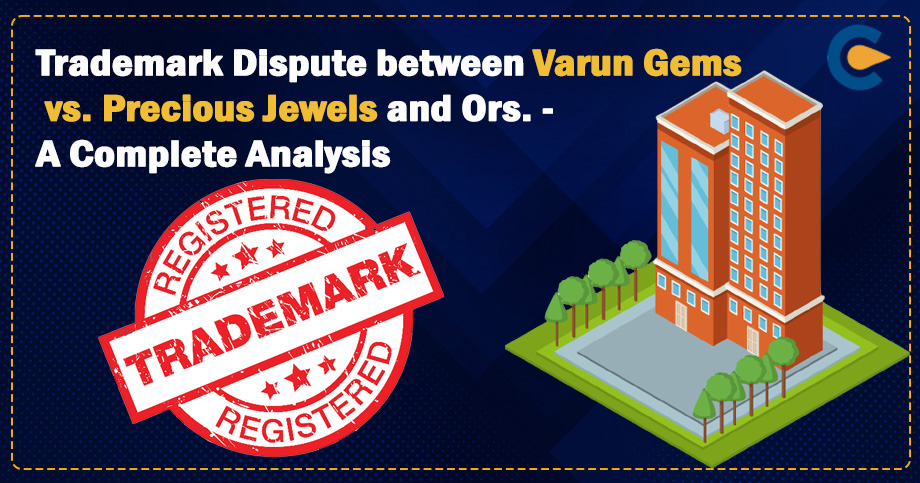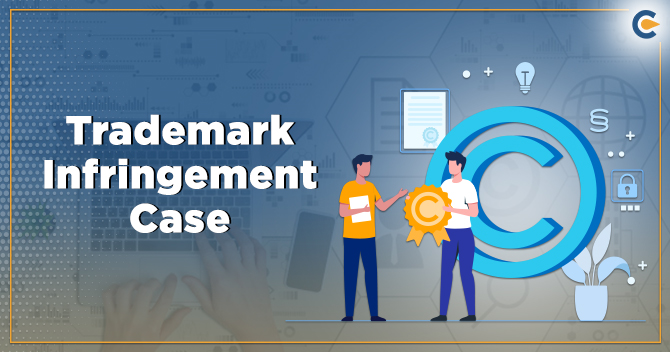The case of Varun Gems vs. Precious Jewels and Ors. was an outcome of the infringement of legal rights obtained by a registered trademark under the Trademarks Act 1999. The case brought into question the use of the term “bona fide”, as mentioned in section 35 of the Trade Marks Act, 1999. The order of the case was passed on 6th October 2022.
Overview of the Trademarks Act, 1999
A Trademark can be a name, sign or mark that separates one business from the other. It acts as a symbol of business recognition and ensures trust, quality and service of a particular business to be its own. By registering a trademark, a business ensures that its name, mark or sign cannot be used by any other business or any other competitor in the market.
The law of trademark in India had no existence before 1940. It had caused several problems of registered and unregistered trademark infringement resolved by the Specific Relief Act, 1877 and the Indian Registration Act, 1908. Later, in 1940, the government enforced Indian Trademark Law[1] to overcome these issues. The demand for trademark protection increased significantly after the law was introduced.
The Trademark and Merchandise Act, 1958 replaced the Trademark law to protect trademarks and prevent merchandise fraud or misuse. The Act also allowed the registration of trademarks to get legal rights over them.
Later, the Trademark and Merchandise Act of 1958 got replaced by the Trademark Act of 1999 by the government. The Act complied with TRIPS (Trade-related aspects of intellectual property rights) recommended by the World Trade Organization.
The Objective of the Trademark Act 1999 is to provide security and protection to the registered trademark users and provide legal remedies for implementing them. It gives the right the police to arrest in cases of infringement of trademarks.
Case analysis of Varun Gems vs. Precious Jewels and Ors.
The case between the parties (Appellant) Varun Gems vs. Precious Jewels and Ors. (Respondent) was decided by the High Court of Delhi on 6th October 2022.
Coram
Hon’ble Mr Justice Vibhu Bakhru
Hon’ble Mr Justice Amit Mahajan
Facts of the Case
The facts of the Varun Gems vs. Precious Jewels and Ors. are that the Appellant M/s Varun Gems has been running a jewellery business under the registered trademark “Rakyan’s Fine Jewellery”. Mr Jitendra Kumar Rakyan is the Managing Partner of M/S Varun Gems and is also related as the paternal uncle of respondent number 2.
The background of the case is that in 1951, one late sh. Sital Dass Rakyan, the father of Mr Jitendra Kumar Rakyan, started up a jewellery business in Delhi under the name M/s Sital Dass & Sons. Subsequently, in 1961, Mr. Sital Dass Rakyan formed a partnership between four partners-
- Mr. Surendra K Rakyan
- Mr. Rajendra K Rakyan
- Mr. Virendra K Rakyan and
- Mr. Jitendra K Rakyan
One year later, in 1962, Mr Surendra K Rakyan retired from the business and moved to Jaipur to start his separate business named “Rakyans Jewellers” in partnership with his uncles. The remaining three partners stayed in Delhi, continued with the same jewellery business under different names, and gradually constituted their firms.
Later, in 1978, all the partners of M/s Sital Dass & Sons formeda new partnership firm named Virendra Kumar and Co., which was later reconstituted as Sital Dass Sons in 1982. After that, all the partners of the newly constituted partnership firm Sital Dass Sons started theirseparate businesses under the name Sital Dass jewellersat various places in Delhi.
In 2000, Jitendra K Rakyan opened a shop at M-31, M-Block Greater Kailash, New Delhi and got the trademark of “Rakyan fine jewellery” in 2005. The trademark was registered under the name of the partnership firm “Varun Gems”.
Later, in the year 2011, Mr Rajendra K Rakyan’s son and Mr Jitendra K Rakyan’s nephew- Mr Ravi Rakyan alsoopened a shop at M-32, M-Block Greater Kailash, New Delhi, by the name “DIAMEZ” which was located right next to Jitendra K Rakyan’s shop.
Later, in the year 2012, The name “DIAMEZ” was changed to “Neena and Ravi Rakyan“, which caused an Issue trademark dispute between the name “Rakyan fine jewellery” registered as a trademark under the firm “Varun Gems” and “Neena and Ravi Rakyan” of Ravi Rakyan.
An ex-parte injunction was granted in an order dated 1st June 2012, where the respondents were restrained from using the name “Rakyan” or any other mark which is deceptively similar or identical to their trademark “Rakyan’s Fine Jewellery.”
The respondents appealed the decision to the division bench and later, to Supreme Court. The Hon’ble Apex court vacated the Injunction. The appeal was filed for the order which had vacated the Injunction under the following reasons –
- The court concluded that the hoardings of both shops did not have any similarity.
- According to Section 35 of the Act, there is no prima facie case in favour of the plaintiff. Therefore, there was no reason to restrain the defendant, so the impugned order was quashed and set aside, and interim relief was granted in favour of the plaintiff.
The proceedings were not participated by the respondent, and an Ex parte order was passed on 11th July 2017, where the Appellant led the evidence.
Even though the respondent had not contested the suit, the single learned judge dismissed the suit on the ground that the SC had removed the interim Injunction on the following grounds-
- The plaintiff was not entitled to Injunction given Section 35 of the Trade Marks Act, which allows anyone to run a business in his name in a bona fide manner. The defendants were running a business in their name in a bona fide manner, which was not a dispute.
- Also, both parties were from the same family, and the whole family has been running the jewellery business.
- Also, there were no similarities found between the hoardings of both businesses.
Sections Involved in the Case
The case of Varun Gems vs. Precious Jewels and Ors. Involved rules and regulations of the Trade Marks Act, 1999, in the proceedings. The laws involved are as follows-
- Section 2 (m), Trade Marks Act, 1999-
“Mark” includes a device, heading, brand, label, name, ticket, signature,letter, word, numeral, packaging, shape of goods or combination of colours or any combination thereof.
- Section 35, Trade Marks Act, 1999-
Saving for the use of the name, address or description of goods or services- Section 35 of the Act explains that no proprietor or a registered user of a registered trademark shall interfere with any bona fide use of the name of a person or his place of business or any character or quality of his goods or services.
- Section 28, Trade Marks Act, 1999-
Rights conferred by registration– Section 28 of the Act gives exclusive right to the trademark proprietor to use the mark about goods and services in respect of which the same is registered.
- Section 29, Trade Marks Act, 1999-
Infringement of registered Trade Marks- Section 29 of the Act provides that a registered mark is infringed by a person who, not being a registered proprietor or assignee, uses a mark which is identical and deceptively similar in relation to the said goods and services and also if the use of the said mark is likely to confuse the part of the public.
Issues of the Case
The Issue raised in the case Varun Gems vs. Precious Jewels and Ors. Was that the court had rejected the Appellant’s plea for restraining the respondent from using the name “Rakyan” or any other name or mark similar to their registered trademark “Rakyan’s Fine Jewellery” and allowed the respondent to use the name for his business.
Arguments of the Case
The Issue raised by the case Varun Gems vs. Precious Jewels and Ors. Led to the argument that the order of dismissal of the Injunction was ex-facie erroneous and based on the prima facie view of the court.
An argument was also raised that the evidence, once submitted, must be accepted unless it’s contradicted by way of cross-examination and is sufficient to dislodge the prima facie view that the plaintiff is not entitled to Injunction.
The Appellant also raised an argument stating that he had no objection if the respondents continued to use the impugned mark or name unless it was not used in connection with the business from the adjoining premises or in the same market.
The Decision of the Case
In the case Varun Gems vs. Precious Jewels and Ors. The court had set aside the Judgement passed by the Single Judge, which vacated the Injunction. The court, in the order dated 6th October 2022, put an Injunction on the respondent from using the name “Rakyan”’ or any other name or mark similar to their registered trademark “Rakyan’s Fine Jewellery”, from any shop which is located within a radius of two km of the Appellant’s premises.
Case Analysis
The case of Varun Gems vs. Precious Jewels and Ors. has highlighted the use of the term “bona fide”. The plaintiff, during the case, had established that they had done various activities to promote the brand “Rakyan’s” and “Rakyan’s fine jewellery”. The plaintiffs also established that the defendant’s business name was “DIAMEZ” earlier, which had been changed to “NEENA AND RAVI RAKYAN”, which caused confusion between both plaintiff and the defendant’s businesses.
With this evidence submitted by the plaintiff, it can be said that the use of the name “Rakyan” was not bona fide in nature. The fact that they had changed their business name from “Diamez”, as mentioned earlier, and that the business was commenced from the adjoining premises is sufficient to conclude that the defendants were not entitled to the benefit of section 35 of the Trade Marks Act, 1999.
Read Our Article:Trademark Infringement: Meaning, Types and Remedies










